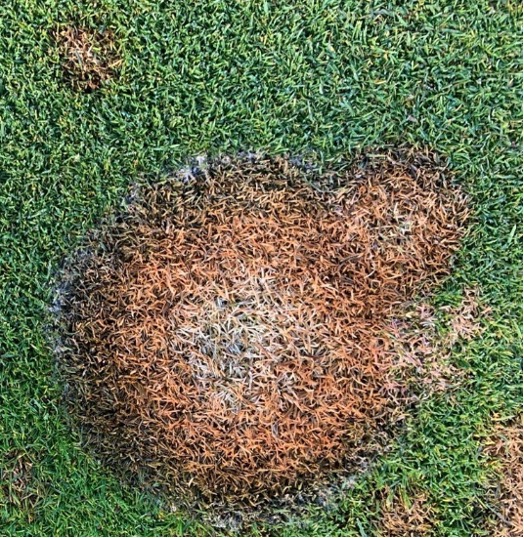Manage Microdochium Patch and Dollar Spot
Our Envu Australia team shares agronomic tips for golf course superintendents “down under” and around the world
Microdochium patch (Microdochium Nivale), also known as winter fusarium, can be a tough problem on turf throughout the cooler months of the year and in cool to warm, wet weather.
What to Look For
Symptoms start off as small, water-soaked spots on turf that expand and turn gray or tan with a red-brown or dark, greasy-appearing margin. Fluffy, white mycelia can be observed at the edge of the patches, and often, dead tissue is covered by pink spore masses.
Wet conditions during maximum daytime temperatures of 7° C to 20° C favor this disease, and explosive outbreaks can occur when daytime temperatures are 15° C to 20° C with overcast, foggy or wet weather. It is most common on cool-season turf, especially winter grass, but it can occur on warm-season turf such as couch grass and Kikuyu. This disease is favored in shaded or poorly drained locations and excessive nitrogen fertility conditions.
The Solution
Rotate fungicide classes when multiple applications are used in the season for Microdochium patch control to prevent resistance development. An addition of a multisite fungicide when making curative applications will also help minimize resistance development.
Severe Microdochium patch symptoms include water-soaked spots that turn gray or tan with a red-brown or dark, greasy-appearing margin. Fluffy, white mycelia can be observed at the edge of the patch.
Dedicate® FORTE Stressgard® fungicide in curative trials has demonstrated excellent curative activity of Microdochium patch with long residual, good turf safety and the added benefits of Stressgard technology.
Dollar Spot
The Problem
Dollar spot, caused by Clarireedia spp., is a widespread and very destructive turfgrass disease that can be observed throughout the year. Dollar spot is known to attack most cool- and warm-season turfgrass species, including winter grass, bentgrass, fescue, kentucky bluegrass, perennial ryegrass, couch grass, zoysia and buffalo.
What to Look For
Dollar spot is favored by air temperatures ranging from 16° C to 32° C (optimum 21° C to 27° C), with extended periods of high humidity (>85% at night). The disease tends to be most severe with warm days, cool nights, infrequent rain but long dew periods, daily ground fog that extends leaf wetness periods, and low nitrogen fertility.
Dry weather and extended periods of high temperature above 35° C may shut down summer epidemics of dollar spot. However, autumn outbreaks are common due to either a return to disease-conducive temperatures, increases in moisture or rainfall, or a reduction in cool-season turfgrass vigor.
Symptoms of dollar spot can vary based on the turfgrass species and height of cut. Under close mowing heights, as with intensively maintained bentgrass or winter grass, the disease appears as small circular straw-colored spots of blighted turf 2-5 cm in size. On coarser-textured turf maintained under higher mowing practices, the blighted areas can be larger, straw-colored patches 2-15 cm in diameter. Affected patches frequently coalesce and involve large areas of turf.
Distinct hourglass-shaped lesions often develop on infected leaves. On short-mowed turf, whole leaves may become blighted without distinct lesions.
When the fungus is active and leaf surfaces remain wet, a fine, white, cobwebby mycelium covers the infection centers or diseased patches during early morning hours.
The Solution
Implementing proper cultural practices is crucial to reducing disease severity. Management tactics include maintaining adequate nitrogen, especially with spoon-feeding during the summer on low mowed, cool-season turf; removing dew; avoiding drought stress; alleviating compaction and thatch; and maximizing air movement.
Fungicides are a key part of an integrated dollar spot management program. Since dollar spot is a foliar disease, select spray nozzles and volumes that provide good coverage to maximize fungicide activity. Early spring applications of fungicides can significantly delay the onset of dollar spot epidemics. DMI fungicides timed for fairy ring and patch disease control (average soil temperatures of 13° C at a 5-10 cm depth) can provide early season dollar spot control. Routine fungicide applications are commonly needed through the summer when air temperatures are 21° C to 32° C and should be continued into the autumn for dollar spot control.
Resistance to certain classes of fungicides can be significant for dollar spot. Resistance to the benzimidazole fungicides is common. Resistance to SDHI fungicides is suspected but not officially validated yet, but it is critical to avoid overuse of this expanding group of fungicides to limit the chances of resistance developing. Preventive applications and rotating fungicide classes, including the use of multisite fungicides, are important for reducing the risk and impact of resistance.
Envu Turf & Ornamental management team members are committed to providing highly effective, flexible products that provide you with the power to reclaim the land. To find out more information, reach out to our team.
Always read the label before use

